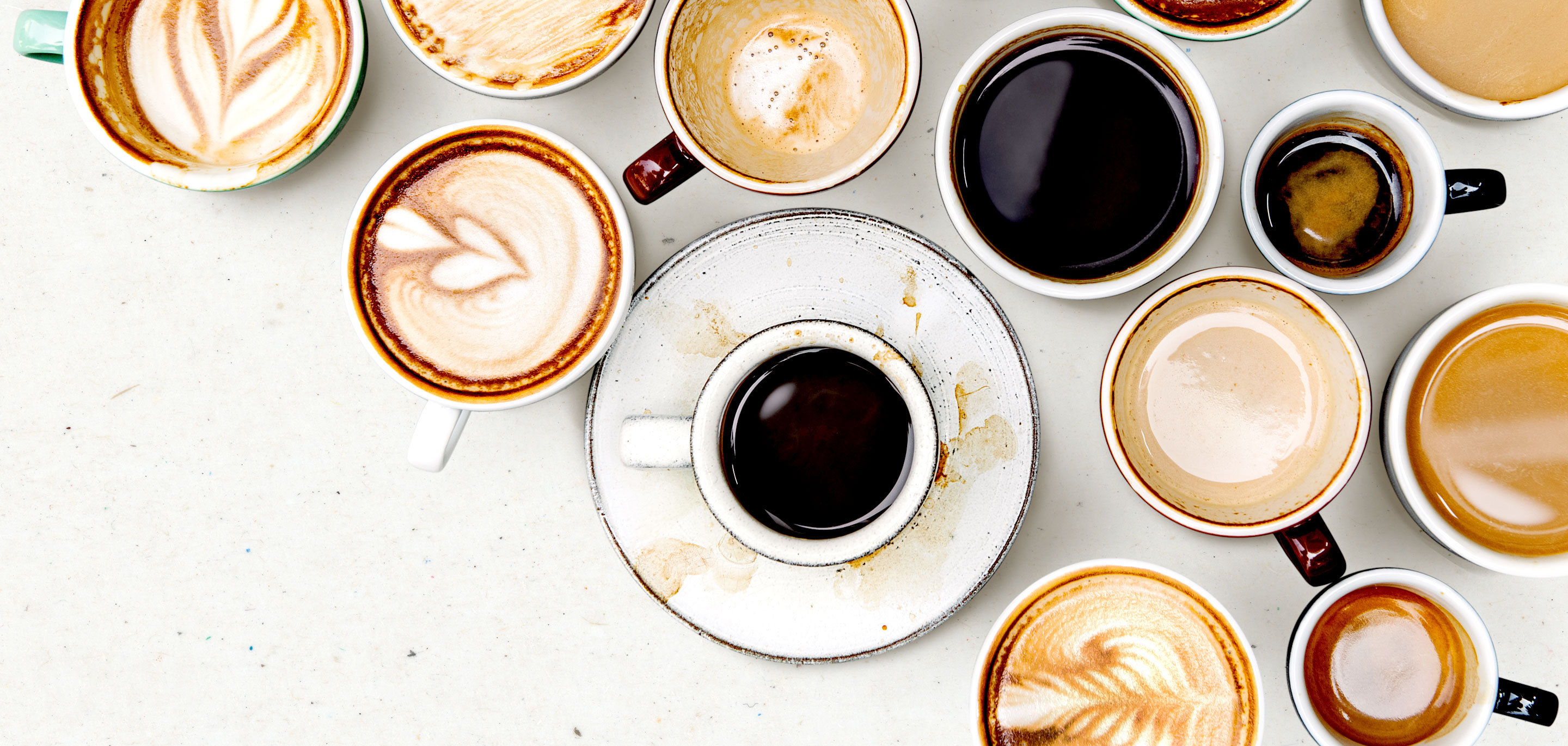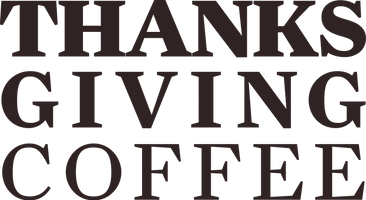
Coffee 101
View BY :

Earning Beans For Coffee Rewards
Thanksgiving Coffee Company Appreciates You We have made it simple and effective for you to get the appreciation we think you deserve. It is the “Earn Beans” reward system. Yay! These rewards will be counted as “beans” which you can redeem as discounts. The more beans you earn the greater the discount, all the way up to free products!
read more-
![5 Steps to Perfectly-Brewed Drip Coffee]()
Learn how to make perfect drip coffee.
By Roastmaster, Jacob Long
Some things to keep in mind before brewing:
- Different roast colors brew best at different grinds. The best way to ensure your grind is correct is to have us grind it for you. We calibrate our grinds regularly to bring the best out of each roast color. If you are fresh-grinding your own drip coffee, talk to us about how to get the best results from your grinder.
- We recommend using 2 heaping tablespoons of coffee grounds per 8 oz. of water.
- For best taste, pre-ground coffee should not sit for longer than one week. Purchase whole beans and grind fresh at home.
- If you are storing your coffee in the refrigerator, be sure to take out enough for each pot and let it warm to room temperature before brewing. Avoid repeatedly taking the coffee package out of the fridge for brewing, as this allows water to condense on the coffee, which will make it go stale more quickly. In addition, using cold grounds to brew coffee will affect brew temperature and not allow the water to make the correct extraction.
- Before starting the brew cycle, ensure the spray head (underside of brew basket) and surrounding areas are clean by wiping them with a clean rag. (Tip: dirty spray heads are a common reason for poor-tasting coffee, and accumulated coffee will eventually affect how the spray head functions)
- Although it's tempting to "sneak a cup" before brew cycle is finished, doing so will result in unbalanced flavors. Not what you want in your morning cup.
Brewing Instructions
Step 1:
- Place filter with the correct dose of room-temperature ground coffee into the brew basket.
- Use our recommendation of 2 heaping tbsp per 8 oz. water.
Step 2:
- Gently shake brew basket to ensure coffee is well-distributed, and return brew basket to brewer.
Step 3:
Brewing the coffee:
- If using a pour-over brewer, pour desired amount of, ideally cold, filtered tap water into the top of brewer to initiate brew cycle.
- If using a plumbed-in brewer, hit the button to start the brew cycle.
Step 4:
- After the brew cycle has finished, for ideal taste, pour coffee into a preheated insulated container.
- Do not keep coffee on burner.
- Rinse and return the carafe.
Step 5:
- Empty used coffee out of brew basket, rinse brew basket of any extra grounds, and wipe spray head and surrounding areas with a clean rag.
- Finally, enjoy your coffee! :)
This month's featured coffees - 20% off!
Like us on Facebook and follow along on Instagram and Twitter for frequent updates, promotions, giveaways and more!
5 Steps to Perfectly-Brewed Drip Coffee
read more -
![Coffee Tips: Part II - 7 Ways to Brew Your Coffee]()
7 Ways To Brew Your Coffee
We’ve talked about the basics, now let’s get into the fun stuff. We hope this post will help you find your ideal coffee brewing method. As with anything, there are pros and cons to each method – and we’ve done all the work and research for you.
1. Stovetop
This one is perfect for you if you want homemade espresso but don’t necessarily want to drop a couple hundred dollars on a fancy machine. The result is rich, delicious coffee that you can craft into lattes or just enjoy by itself.
Grind
Start with a fine grind setting (#3.5), slightly coarser than texture of granulated sugar. When pinched, the ground coffee should not compress or clump.
Directions
- Fill the coffee chamber with finely ground coffee, be careful not to pack the coffee too densely.
- In a kettle, boil enough water to fill the water chamber.
- Place freshly boiled water in the water chamber, place coffee-filled chamber on top, and, using a towel or pot holder to protect your hand from heat, screw on the brewed coffee chamber.
- Place the stove top espresso maker on a burner at low to medium heat.
- As the coffee brews, watch and listen for a sputtering noise; this signals the end of the brewing. Immediately remove the espresso maker from the stove and run the bottom (water chamber) under cold water for 10 seconds to cool the chamber and stop the extraction.
- Serve your fresh espresso and enjoy.
Pros:
- Rich, delicious coffee
- Inexpensive espresso machine alternative
- Quick
- Easy to clean
Cons:
- Learning curve
- Needs your attention for the entire brewing process
2. French Press
The French Press is popular for its ease to learn and use, affordability and it’s nice and compact – doesn’t take up too much space in the kitchen.
Grind
Start with a coarse grind setting (#8) approximately the size and texture of kosher salt. The particle size should be flaky, with visible chunks.
Directions
- Measure 2 grams for every ounce of water or 2 generously heaping tablespoons of ground for every 5 ounces of water.
- Bring water to a boil and pour a small amount into the press to pre-heat.
- Let the water drop to 200 degrees, about 2 minutes off boil.
- Pour out water used to pre-heat, pour in measured ground coffee, and pour the water to saturate grounds.
- Start timer. At one minute, gently stir dry cap with a spoon to completely saturate coffee in water. Place the top over the press.
- At 4 minutes, slowly press the coffee.
- Serve and enjoy.
Note: Experiment with a finer grind for a more intense brew, or a coarser grind for a less intense brew.
Pros:
- Easy to use
- Easy to clean
- Quick
- Inexpensive
Cons:
- Tends to be inconsistent flavor
- Over-extraction can occur easily
3. Chemex
This one definitely isn’t for beginners. However, once you get the hang of it, the yield from one brew will make it all worth it.
Grind
Start with a medium-coarse grind (#7.5), slightly finer than the texture of kosher salt. The particle size should be flaky, with visible chunks.
Directions
- Measure 2 grams for every ounce of water or 2 generously heaping tablespoons of ground for every 5 ounces of water.
- Separate 3rd and 4th layers of filter and place in Chemex pot.
- Bring water to boil and pour a small amount of water (approximately 4 ounces) through the filter-lined cone to rinse the paper filter and warm the pot below.
- Let the water drop to 200 degrees, about 2 minutes off boil. Empty the water that was used to rinse the filter and warm the pot.
- Place ground coffee in the rinsed and filter lined cone and pour a small amount of water (approximately 4 ounces) over the grounds to create saturate and create a bloom. Wait 45 seconds.
- As the bloom settles, continue the pour as slowly as possible, stopping the pour as necessary so that the water never reaches above the original bloom volume. This will require stopping the pour every 15–30 seconds. Pour slowly and in a circular motion, with the goal of dispensing the total water used to brew in 3–4 minutes.
- Remove the used filter and coffee and swirl the brewed coffee for 10 seconds.
- Serve and enjoy.
Note: If the brew time is less than 3–4 minutes and the taste is weak, experiment with a finer grind. If the brew time is more than 3–4 minutes and the taste is bitter, experiment with a coarser grind.
Pros:
- Depending on the size, it can yield large amounts
- Unique, clean tasting coffee – full flavor profile
Cons:
- Fragile design
- Learning curve
- Tricky to clean
4. Hario
There’s a reason this Japanese pour-over method is a popular one. It’s simple, elegant and delivers fresh, delicious coffee with ease.
Grind
Start with a medium-fine grind (#5.5), somewhere between the texture of granulated sugar and couscous.
Directions
- Measure 1.5 grams for every ounce of water or 2 heaping tablespoons of ground for every 5 ounces of water.
- Place paper filter in cone over cup or pitcher.
- Bring water to boil and pour a small amount of water (approximately 4 ounces) through the filter-lined cone to rinse the paper filter and warm the server below.
- Let the water drop to 200 degrees, about 2 minutes off boil. Empty the water that was used to rinse the filter and warm the server.
- Place ground coffee in the rinsed and filter-lined cone and pour a small amount of water (approximately 4 ounces) over the grounds to saturate and create a bloom. Wait 45 seconds.
- As the bloom settles, continue the pour as slowly as possible, stopping the pour as necessary so that the water never reaches above the original bloom volume. This will require stopping the pour every 15–30 seconds. Pour slowly and in a circular motion, with the goal of dispensing the total water used to brew in about 3 minutes.
- Remove the used filter and coffee and swirl the brewed coffee for 10 seconds.
- Serve and enjoy.
Note: If the brew time is less than 2:30–3 minutes and the taste is weak, experiment with a finer grind. If the brew time is more than 3–3:30 minutes and the taste is bitter, experiment with a coarser grind.
Pros:
- Compact and stylish
- Easy
- Smooth coffee finish
- Inexpensive
- Easy to clean
Cons:
- Needs special filters
- Not as rich in flavor
- Learning curve with pouring the water
5. Aeropress
Fun fact: the Aeropress was invented by Alan Adler, founder of Aeropress – formerly known as Aerobie, a company specializing in outdoor flying discs and sports toys including the Aerobie Pro flying ring, which was used to set a Guinness World Record for farthest thrown object (at a distance of 1,333 feet to be exact). ALSO, that record happened to be set by Erin Hemmings, who grew up here on the Mendocino Coast!
The Aeropress is a unique way to get a quick cup of coffee on the go, and it’s so easy to bring with you anywhere.
Grind
Start with a medium-fine grind (#5.5), somewhere between the texture of granulated sugar and couscous.
Directions
- Place paper in black filter cap and lock onto brew chamber, place over cup.
- Bring water to boil and pour a small amount of water (approximately 4 ounces) through the filter-lined and capped brew chamber to rinse the paper filter and warm the server below.
- Let the water drop to 200 degrees, about 2 minutes off boil. Empty the water that was used to rinse the filter and warm the server.
- Fill brew chamber to just below the “1” mark with coffee.
- Pour approximately 2 ounces of water onto the ground coffee in the brew chamber. Start timer.
- Wait 30 seconds for the bloom to settle.
- Slowly fill with water to just above the “4” mark, stir gently, and wait one minute.
- Place plunger and slowly plunge brew into cup.
- Serve and enjoy.
Pros:
- Easy to travel with/pack up
- Can brew coffee, espresso and cold brew
- Quick
- Easy
Cons:
- Small yield, 1-2 servings
6. Melita/Cone
Grind
Start with a medium-coarse grind (#7.5), slightly finer than the texture of kosher salt. The particle size should be flaky, with visible chunks.
Directions
- Measure 2 grams for every ounce of water or 2 generously heaping tablespoons of ground for every 5 ounces of water.
- Place paper filter in cone over cup.
- Bring water to boil and pour a small amount of water (approximately 4 ounces) through the filter-lined cone to rinse the paper filter and warm the cup below.
- Let the water drop to 200 degrees, about 2 minutes off boil. Empty water used to pre-heat cup.
- Place ground coffee in the rinsed and filter-lined cone and pour a small amount of water (approximately 4 ounces) over the grounds to saturate and create a bloom. Wait 45 seconds.
- As the bloom settles, continue the pour slowly, stopping the pour as necessary so that the water never reaches above the original bloom volume. Pour slowly and in a circular motion, with the goal of dispensing the total water used to brew in 3-4 mintues.
- Serve your fresh brewed coffee and enjoy.
Note: Experiment with a finer grind for a more intense brew, or a coarser grind for a less intense brew.
Pros:
- Easy to travel with/pack up
- Can brew coffee, espresso and cold brew
- Quick
- Easy
Cons:
- Small yield, 1-2 servings
7. Cold Brew
What is Cold Brew?
Cold coffee is the chilled-out variant of the hot coffee you know and love. More then just a cooler brew, cold coffees have their own distinct flavor profiles due to the differences in how the essential oils are extracted from the coffee bean; cold and slow vs. hot and fast.
Most coffee retailers use hot-brewed coffee in their iced coffee drinks because it is faster/easier. They will typically brew hot with twice the amount of grounds for a double-strength concentrate that can be refrigerated and diluted. Unfortunately, this method completely misses the many benefits that cold-brewed coffee has to offer.
Cold-brewed coffee is 67 percent less acidic than coffee that is hot-brewed.
Directions
How It's Made
Cold-brewed coffee is made by soaking coffee grounds in cold water for 12 or more hours, usually brewed overnight. This method allows for a slow extraction of the coffee’s flavor, producing a super-smooth brew that has 67% less acidity than conventional hot-brewed coffee. This means that cold-brewed coffee is less bitter and easier on sensitive stomachs.
In addition to being smooth and low on acidity, cold-brewed coffee keeps for significantly longer with no loss of flavor. By brewing cold, the flavor compounds within the coffee are more stable and won’t degrade as quickly as hot brewed coffee, which can become overly bitter in a matter of hours.
A batch of cold-brewed coffee can last for up to two weeks.
Cold-brewing offers an alternate way to enjoy our delicious coffees. Try your favorite coffee brewed cold and taste the difference for yourself.
Pros:
- Smoother, less bitter than hot-brewed coffee
- Refreshing summer beverage
Cons:
- Long brewing time
Resource for 2023 Brewing Gifts
We hope you learned something new! Did you find a new brewing method to try, or confirm that your current favorite is the only way? Let us know! Remember to follow us on social for more brewing tips and to join the conversation.
Coffee Tips: Part II - 7 Ways to Brew Your Coffee
read more




